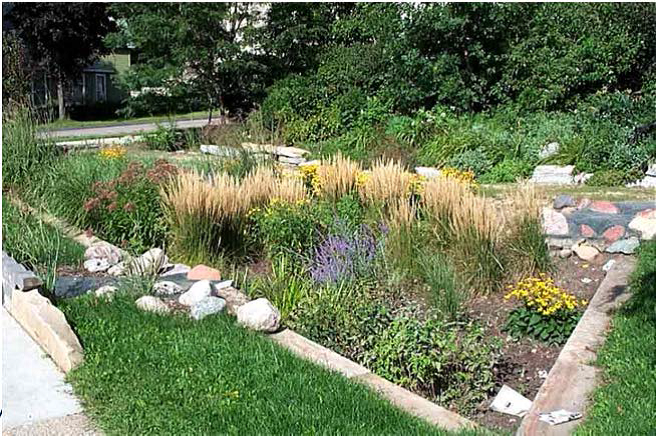Rain gardens are small-scale vegetated gardens used for storage and infiltration. The term ‘rain garden’ is often used interchangeably with ‘bioretention area’ (although the latter could also be applied more loosely to other measures such as filter strips or swales).
Rain gardens are typically applied at a property level and close to buildings, for example to capture and infiltrate roof drainage. They use a range of components, typically incorporated into the garden landscape design as appropriate. These components may include:
- Grass filter strips to reduce incoming runoff flow velocities and to filter particulates. For example, these may be used at the base of roof drainage downspouts to slow and filter roof runoff as it enters the rain garden.
- Ponding areas for temporary storage of surface water prior to evaporation, infiltration or plant uptake. These areas will also promote additional settling of particulates.
- Organic/mulch areas for filtration and to create an environment conducive to the growth of micro-organisms that degrade hydrocarbons and organic matter. These may be particularly effective where rain gardens are used to treat excess highway runoff.
- Planting soil, for filtration and as a planting medium. The clay component of the soil can provide good adsorption for hydrocarbons, heavy metals and nutrients.
- Woody and herbaceous plants to intercept rainfall and encourage evaporation. Planting will also protect the mulch layer from erosion and provide vegetative uptake of pollutants.
- Sand beds to provide good drainage and aerobic conditions for the planting soil. Infiltration through the sand bed also provides a final treatment to runoff.
The filtered runoff is then either collected and returned to the conveyance system (using an underdrain) or, if site conditions allow, infiltrated into the surrounding ground. They aim to capture and treat stormwater runoff from frequent rainfall events, while excess runoff from extreme events is passed on to other drainage features as part of a SuDS ‘train’. Rain gardens should be planted up with native vegetation that is happy with occasional inundations. Rain gardens are applicable to most types of development, and can be used in both residential and non-residential areas. They can have a flexible layout and should be planned as landscaping features, enhancing the amenity value.

Rain garden
Source: Andras Kis’ presentation, NWRM Workshop 1
| Benefits | Level |
|---|---|
|
ES1 - Water storage
|
Low
|
|
ES3 - Natural biomass production
|
Low
|
|
ES4 - Biodiversity preservation
|
Medium
|
|
ES5 - Climate change adaptation and mitigation
|
Medium
|
|
ES6 - Groundwater/aquifer recharge
|
Medium
|
|
ES7 - Flood risk reduction
|
High
|
|
ES8 - Erosion/sediment control
|
Low
|
|
ES9 - Filtration of pollutants
|
Medium
|
|
ES10 - Recreational opportunities
|
Medium
|
|
ES11 - Aesthetic/cultural value
|
Medium
|
|
PO2 - Improving status of physico-chemical quality elements
|
Low
|
|
PO4 - Improving chemical status and priority substances
|
Low
|
|
PO5 - Improving quantitative status
|
Medium
|
|
PO7 - Prevent surface water status deterioration
|
Medium
|
|
PO8 - Prevent groundwater status deterioration
|
Low
|
|
PO9 - Take adequate and co-ordinated measures to reduce flood risks
|
High
|
|
PO11 - Better protection for ecosystems and more use of Green Infrastructure
|
High
|
|
PO14 - Prevention of biodiversity loss
|
Medium
|
|
BP1 - Store runoff
|
Medium
|
|
BP2 - Slow runoff
|
Medium
|
|
BP5 - Increase evapotranspiration
|
High
|
|
BP6 - Increase infiltration and/or groundwater recharge
|
High
|
|
BP7 - Increase soil water retention
|
Low
|
|
BP8 - Reduce pollutant sources
|
Low
|
|
BP9 - Intercept pollution pathways
|
Medium
|
|
BP10 - Reduce erosion and/or sediment delivery
|
Medium
|
|
BP14 - Create terrestrial habitats
|
High
|
|
BP16 - Reduce peak temperature
|
Medium
|
|
BP17 - Absorb and/or retain CO2
|
Low
|
